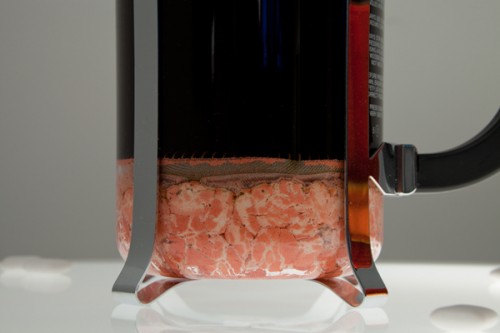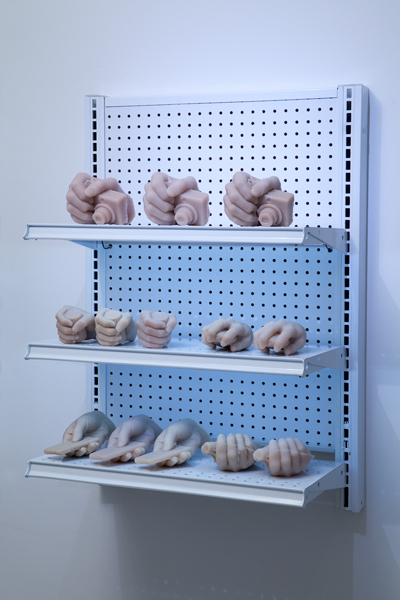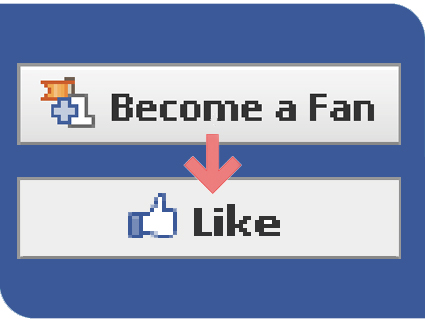
Josh Kline. "Sleep is for the Weak," installation detail, 2011. Bodum French press coffee makers, Coke Zero infused with Ibuprofin (pictured), DayQuil infused with Dentyne Ice, Redbull infused with Vivarin. 43 x 36 x 11 3/4 inches.
The following interview between artist Josh Kline and I was conducted via email. We cover work, media, hands, and the end. 2012!
Amanda Beroza Friedman: For your current exhibition, Dignity and Self-Respect, the press release is amazing. And fatal. Is the world ending? What do the ’90s have to do with it?
Josh Kline: Someone’s world is always ending. That’s the nature of aging and death. The teenagers and twentysomethings of the ’90s, born in the ’70s and early ’80s, are finally moving into undeniable and irreversible adulthood. It’s extremely difficult to use thirtysomethings to sell youth culture.
Unlike previous generations of artists and musicians, this generation moved into early adulthood absolutely thrilled to participate in focus groups and pose for product-placement shots in exchange for sponsored drinks, complimentary magazines, unpaid jobs, and the chance to be near some reissued retro sneakers. You spill your personal problems and innermost secrets on social media and Facebook turns it into entertainment for other people and sells advertising around it. Even after the asteroid hits the Earth, some life will go on. In this vision of the future, people will continue, but perhaps as products and services instead of as human beings.
In my show at 47 Canal, a lot of the work comes out of thinking about this transition, about the transformation of creative people into mass-produced or mass-distributed goods, services, or advertising. It’s also about a generation in the process of being deprecated by the market as trend forecasters look to the tastes of the young people of today for this season’s sounds and colorways. The youth culture of the ’90s and of the 2000s are reference points for the show, but the installation’s setting is today.
ABF: Your work speaks to communication strategies. Over the last few months, the occupation movement has brought back hand signals, chanting, and the general consensus model of group governing. From where you stand, how is Occupy Wall Street doing with communication?
JK: I think Occupy Wall Street is doing an incredible job with communication. Less than four months ago the entire conversation on the news was about austerity, deficit reduction, and finding more ways to transfer more money from the poor and the middle class to “job creators.” I sometimes wonder if the Democratic Party and their supporters are throwing the game deliberately. The 99% and the 1% is an incredibly persuasive and effective argument.
ABF: Do you read Adbusters? Where do you get your news?
JK: I bought an issue once in the late ’90s and found it forgettable.
I read the news on the Internet at my desk at work while I eat lunch. Also, I’m a podcast junky. I listen to a lot of news while I work in the studio and while I cook.
ABF: What does the creative sector mean to you? How do you define hard work?
JK: I see the creative sector as the area of the economy that encompasses creative workers: artists, designers, people in advertising, filmmakers, writers, stylists, etc. – all of the people who are making a livelihood or trying to make one generating cultural products and services. For me the idea of the creative sector has become synonymous with unpaid or underpaid precarious labor and with debt-driven aspirational lifestyles.
How do you define hard work? For some people it’s thinking and worrying until your stomach hurts. For others it’s working 70-90 hours a week. Or maybe it’s an ideology with roots in Protestantism imported from Northern Europe? If you’re an Indonesian maid working 6-7 days a week in Hong Kong who gets pushed out of a window, maybe it means something completely different.

Josh Kline. "Creative Hands," 2011. 13 pigmented silicone hands on commercial shelving with LED lights from top to bottom, left to right: Photograher’s Hand with Digital Camera (Marcelo Gomes), Studio Manager’s Hand with Advil Bottle (Margaret Lee), Retoucher’s Hand with Mouse (Jasmine Pasquill), DJ/Designer’s Hand with iPhone (Jon Santos), Curator’s Hand with Purell (Josh Kline). Overall: 36 1/2 x 26 1/8 x 15 1/2 inches.
ABF: Hands are important to a maker. What was it like to make those included in “Dignity and Self-Respect” and can you talk about the process?
JK: With the Creative Hands, I wanted to physically appropriate and mass-produce the hands of creative workers, of the people who actually shape our culture. They’re the counterpoint to the show’s lone video What Would Molly Do?, which presents interviews with intern candidates. Whereas in the video I’m presenting interns as subjects, with the hands I wanted to present people successful in the roles that the potential interns aspired to reach – consultants, graphic designers, DJs, curators, studio managers, retouchers, etc. I wanted to show both ends of the commercial creative lifecycle. The hands and the objects they hold are cast in skin-colored silicone rubber – which is already a proxy for flesh. Each person is holding a tool, a piece of lifestyle technology – an iPhone, a mini-bottle of Jameson, a Blackberry, a bottle of Advil, a digital camera, etc. One hand is wearing a carpal tunnel wrist brace.
As subjects, I selected people I knew. Friends. I wanted to implicate and involve my own social network. My own hand is in there holding a bottle of Purell, representing my life as a curator and all the hands I shake. I cast my collaborator Jon Santos’s hand – he’s a celebrated graphic designer and well-known DJ. I cast the hands of a famous artist’s studio manager (who is also an artist I collaborate with and my gallerist); of Ken Miller, the former editor of Tokion; of Cynthia Leung, the head of PR at Balenciaga; of my friend Jasmine Pasquill who retouches images for the covers of major fashion magazines. I brought them in one by one, and with some expert help from other friends (Jesse Greenberg and Margaret Lee), I cast the hands, produced molds and then proceeded to produce a series of rubber sculptures. In many cases the subjects collaborated, selecting the objects in their hand or the gesture that was captured. Ken had the idea to use a mini-bottle of Jameson and Cynthia had a very specific grip in mind for the Blackberry.
ABF: What are you most excited about in 2012?
JK: Excited is probably the wrong word, but I can’t take my eyes and ears off the coverage of the Eurozone meltdown. It’s a non-stop economic cliffhanger. Spring and summer are going to be interesting times.





Pingback: Expo 1 en MoMA PS1 con Adrián Villar Rojas y estudio a77, argentinos en despegue |